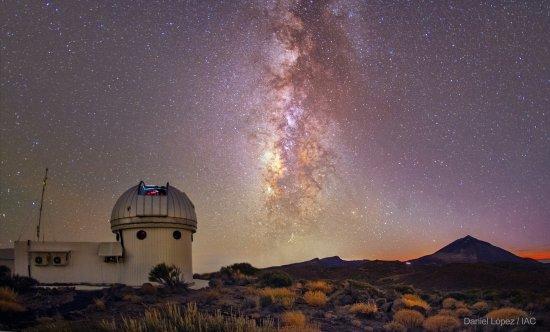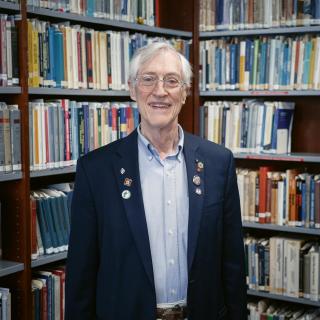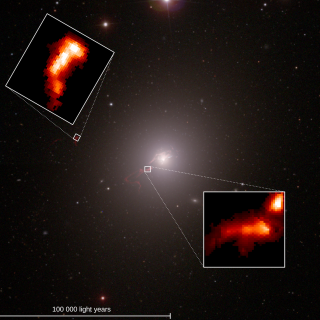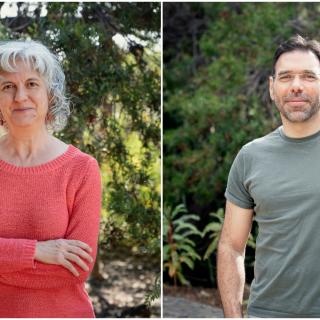Next Saturday, October 25th, at 3 p.m. the inauguration will take place, at the Teide Observatory in Tenerife, of the first telescope of the SONG network, led by the Aarhus University (Denmark) in which the University of Copenhagen (Denmark) and the Institute of Astrophysics of the Canaries (IAC) are members. This ceremony will initiate a global research project which will study, without interruptions, the interiors of stars, and the planetary systems which may surround them.
The official act of inauguration, presided by the Centre for Stellar Astrophysics of the Aarhus University, will be attended by representatives of this university, the University of Copenhagen, and the Institute of Astrophysics of the Canaries (IAC), as well as of authorities and several foundations. In addition researchers who will attend the event include those already participating in the project, and others who have shown an interest in it, from China, Australia, the United States, Chile, South Africa, and Germany.
Stellar observations
SONG is an acronym made up of the initials of Stellar Observations Network Group. This will be the name of eight remotely controlled telescopes, which will carry out coordinated observations to study continuously and without interruption, during 24 hours per day, the interiors of stars, and possibly their planetary systems over long periods of time.
The initiative for this was taken in 2006 by astronomers from the Aarhus University and the University of Copenhagen. The first of the telescopes, which is now to be inaugurated, was installed in 2011, and had its “first light” in June 2012, when measurements were made of the oscillations of one particular star, our Sun, by feeding sunlight directly into the spectrograph on the telescope. This measurement showed that the instrument was working correctly. The software to control the telescope automatically was developed and tested afterwards. Since February 2014 the telescope has been used to observe stars on all clear nights. The official name of the telescope will be the Hertzsprung SONG telescope, in honour of the Danish astronomer Einar Hertzsprung (1873-1967), to whom we owe the Hertzsprung-Russell diagram, a basic research tool which helps us to classify stars according to their luminosities and spectral types.
This ultra-modern prototype telescope has a diameter of only one metre, but is optimized to accomplish the objectives of the project, and was designed to satisfy a series of initial requirements: it had to be low-cost, easy to operate (to be controlled remotely via a normal Internet link) and which could deliver new and original science even before the network of telescopes had been completed.
“I am highly satisfied with the new telescope in Tenerife, above all because it is already operating and producing surprising scientific results” says Jorgen Christensen-Dalsgaard, the director of the Centre for Stellar Astrophysics of the Aarhus University who is the principal investigator of the SONG project.
Rafael Rebolo, director of the IAC sees for this project “promising lines of research for future generations of astrophysicsts, both for the seismic characterization of the stars, and for improving our knowledge of extra-solar planets and their host stars, fields which the IAC has helped to pioneer, and needs to keep on the forefront of research”
Asteroseismology
Asteroseismology is the study of “stellar earthquakes” observed as oscillations at the surfaces of stars. All stars have their “natural oscillation frequencies”, which define uniquely the structural and dynamic properties of their interiors. The question is how to measure them at the surface, and for what types of stars they can be measured. Solar type stars are the most interesting, because they represent the past and the future of what our son was like, and what it will become.
“We are very happy to receive this new telescope in our observatory on Tenerife” comments Pere Pallé, researcher at the IAC, and in charge of the IAC side of the collaboration with SONG. He adds that “SONG decided to put its prototype here because of the quality of the Canarian skies, and because we have been working together for many years in different research collaborations, and because the IAC has a team with a great deal of experience in operating instrumentation of this type”
It was just here, at the Teide Observatory, in 1979, with the Mark-I instrument, the IAC astrophysicist Teodoro Roca Cortés in collaboration with the University of Birmingham in the United Kingdom initiated a method of measuring with precision the natural frequencies of vibration of the Sun. This marked the beginning of helioseismology as a world-wide science. It was quickly realized that it was necessary to obtain uninterrupted observations using world-wide networks or space-borne instruments. The Teide Observatory has, since then, developed into an “astro-strategic node” in the configuration of networks for helioseismology and asteroseismology, the only node in the world which is within all the existing networks and those planned for the future” stressed Pallé.
At the present time the only operative worldwide networks in the field of helioseismology are BISON and GONG, both with instruments in Tenerife, while SONG will be the only network for asteroseismology. This is clearly a more difficult field, because the numbers of photons we receive from other stars are far fewer that those we receive from the Sun. As further information, the first doctoral thesis in Spain in this field was that of the IAC researcher Juan Antonio Belmonte, in 1986. Today asteroseismology is in a golden age of advancement, thanks to the CoROT and KEPLER satellites, where again the IAC has made important contributions.
Extrasolar planets
As well as the study of stellar oscillations SONG is designed to locate and characterize planets around distant stars, and in particular Earth-like planets in orbit around other stars in our Galaxy, the Milky Way. As it happens, the Hertzsprung SONG telescope is mounted on the site where previously there had been another telescope, STARE, with which an IAC group detected the first transiting planet (TrES-1) around a bright star.
The SONG telescope has gone beyond expectation, because as well as achieving its original objectives it is proving to be a complement in time and in scientific range to other missions, like NASA’s KEPLER, and future space-based missions such as ESA’s PLATO mission, (which will study planetary transits and stellar oscillations) and NASA’s TESS mission (a satellite which will make a survey for planetary transits).
For Sara Seager, researcher in the Department of Planetary Sciences and Physics at the Massachussetts Institute of Technology (USA) and a co-investigator on the TESS mission “SONG is the result of an impressive optimization of a small telescope which is now able to make importatn contributions to the process of identifying rocky planets which could harbour life. SONG will be a key telescope for the formation of the team of NASA’s TESS space mission.
According to Uffe Gråe Jørgensen, in charge of the Exoplanet Research Progamme on SONG, and researcher at the Niels Bohr Institute and the Centre for the Study of the Formation of Stars and Planets of the University of Copenhagen “this new telescope is equipped with a technology which can produce images almost as precise as those obtained from space, which will allow us to detect planets as small as the Earth and Mars orbiting other stars.
The SONG network
This project and the Hertzsprung telescope which is to be inaugurated, have been financed by the Carlsberg Foundation, and the VILLUM FONDEN Foundation, the Danish Independent Research Council for the Natural Sciences (FNU), the European Research Council, the University of Copenhagen, the Aarhus University, and the Astrophysics Institute of the Canaries.
As well as the Tenerife telescope another one is under construction by the Chinese partners (presently in the trial phase, and based on the Danish prototype) and there are also plans to construct a SONG instrument in South America. There are also negotiations in progress with the partners in New Mexico (USA), and contacts are being made with other potential partners to complete the network.
Contacts
Pere Pallé (Head of the group at the IAC in the SONG Collaboration)
Instituto de Astrofísica de Canarias
Tenerife. Spain.
Tel. (+34) 922 605 384 / 200
pere.l.palle [at] iac.es (pere[dot]l[dot]palle[at]iac[dot]es)
Jørgen Christensen-Dalsgaard (PI and scientist in charge of Asteroseismology in the SONG project)
Stellar Astrophysics Centre
Aarhus University
+45 2338 2374
jcd [at] phys.au.dk (jcd[at]phys[dot]au[dot]dk)
Uffe Gråe Jørgensen (Head of Exoplanet research in the SONG project)
Niels Bohr Institute & Centre for Star & Planet Formation,
University of Copenhagen
+45 61306640
uffegj [at] nbi.dk (uffegj[at]nbi[dot]dk)
Links:
- SONG web site: http://song.au.dk
- Aarhus University press release
Video: Helioseismology and Asteroseismology World Networks Credit: Gabriel Pérez - SMM (IAC)
Video: “The first SONG telescope”
Other videos: http://song.au.dk/press/
Photos: http://song.au.dk/press/



